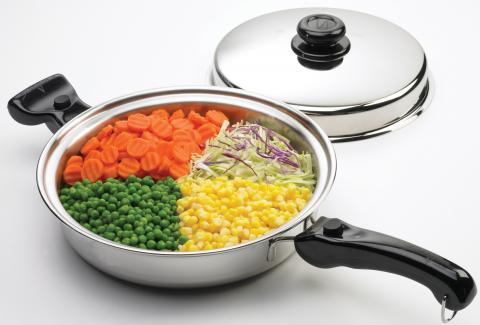PrintEmailSave


Remember that pans should be at least two-thirds full. Avoid peeling vegetables whenever possible, since much of the vitamins and nutrients are in the skins. Follow this simple two-step process:
- Thoroughly rinse fresh vegetables and place directly in correct size pan; pan should be at least three-fourths full. This restores the water lost during shipping and storage. When using frozen vegetables, simply place them in the pan; do not rinse.
- Cover pan and place over medium heat. When the Vapo-Valve™ clicks, reduce heat to low. Begin timing vegetables after the heat is reduced to low, according to the suggested times below.
Vegetable Minutes
| Asparagus, whole spears | 5 - 7 |
| Beans, green or wax | 8 - 10 |
| Beets, red, whole medium | 50 - 60 |
| Broccoli spears | 5 - 7 |
| Brussels sprouts | 9 - 10 |
| Cabbage, sliced | 4 - 6 |
| Carrots, sliced | 9 - 10 |
| Cauliflower, separated | 6 - 8 |
| Celery, sliced | 9 - 10 |
| Corn, kernels, frozen | 1 - 2 |
| Corn-on-the-cob | 10 - 12 |
| Okra, small, whole | 6 - 8 |
| Onions, sliced | 8 - 10 |
| Peas, fresh or frozen | 2 - 3 |
| Peppers, green or red | 3 - 4 |
| Potatoes, sweet, cubed | 15 - 20 |
| Potatoes, white, whole, medium | 20 - 25 |
| Snow peas | 2 - 3 |
| Spinach, fresh | 2 - 3 |
| Squash, summer, sliced | 4 - 6 |
| Squash, winter, diced | 10 - 13 |
| Zucchini squash, sliced | 4 - 6 |
****************************************************************************************
Note: For crisp-tender vegetables, use the briefest times listed. If you prefer more tender vegetables, use the longer cooking times. Frozen vegetables usually require the shorter times. For use in casseroles, vegetables should be undercooked to avoid getting too soft when combined with other ingredients for the final cooking.
